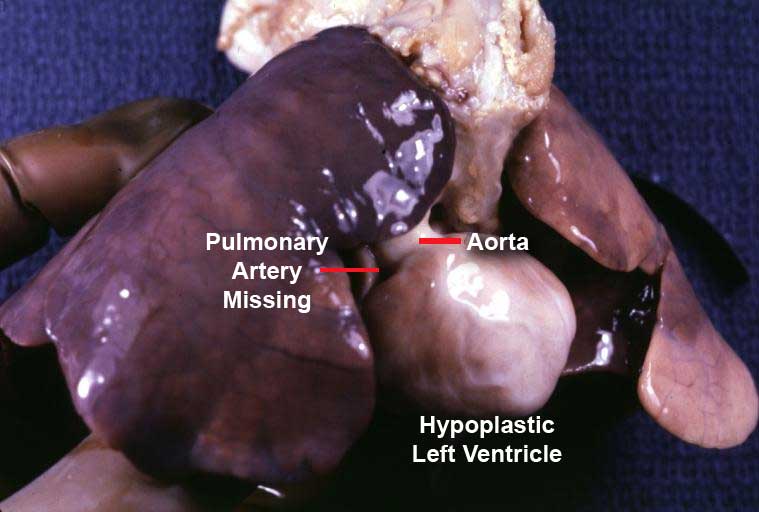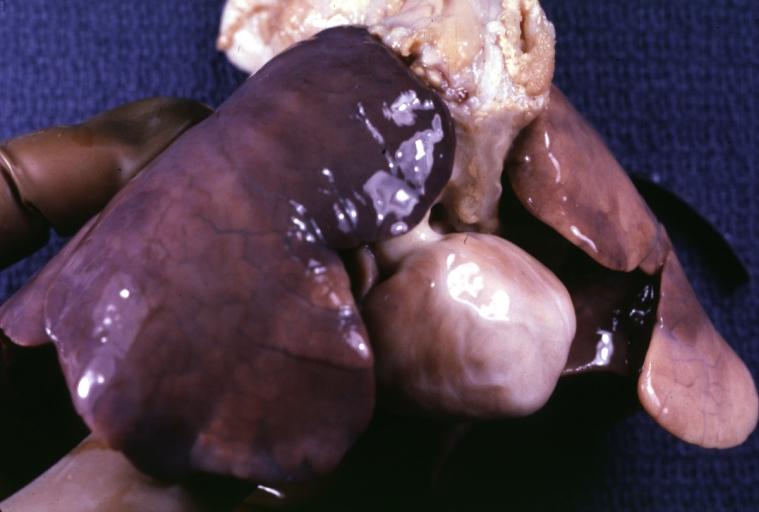Pulmonary atresia: Difference between revisions
No edit summary |
No edit summary |
||
| Line 20: | Line 20: | ||
{{CMG}} | {{CMG}} | ||
'''Associate Editor-in-Chief:''' Keri Shafer, M.D. [mailto:kshafer@bidmc.harvard.edu] | '''Associate Editor-in-Chief:''' [[User:KeriShafer|Keri Shafer, M.D.]] [mailto:kshafer@bidmc.harvard.edu] | ||
{{Editor Join}} | {{Editor Join}} | ||
Revision as of 21:42, 7 January 2009
| Pulmonary atresia | ||
 | ||
|---|---|---|
| Only an aorta can be seen originating from this pathology specimen. No pulmonary artery is present. | ||
| ICD-10 | Q25.5 | |
| ICD-9 | 747.3 | |
| MedlinePlus | 001091 | |
| eMedicine | ped/2526 ped/2898 | |
| MeSH | C14.240.670 | |
|
WikiDoc Resources for Pulmonary atresia |
|
Articles |
|---|
|
Most recent articles on Pulmonary atresia Most cited articles on Pulmonary atresia |
|
Media |
|
Powerpoint slides on Pulmonary atresia |
|
Evidence Based Medicine |
|
Cochrane Collaboration on Pulmonary atresia |
|
Clinical Trials |
|
Ongoing Trials on Pulmonary atresia at Clinical Trials.gov Trial results on Pulmonary atresia Clinical Trials on Pulmonary atresia at Google
|
|
Guidelines / Policies / Govt |
|
US National Guidelines Clearinghouse on Pulmonary atresia NICE Guidance on Pulmonary atresia
|
|
Books |
|
News |
|
Commentary |
|
Definitions |
|
Patient Resources / Community |
|
Patient resources on Pulmonary atresia Discussion groups on Pulmonary atresia Patient Handouts on Pulmonary atresia Directions to Hospitals Treating Pulmonary atresia Risk calculators and risk factors for Pulmonary atresia
|
|
Healthcare Provider Resources |
|
Causes & Risk Factors for Pulmonary atresia |
|
Continuing Medical Education (CME) |
|
International |
|
|
|
Business |
|
Experimental / Informatics |
| Cardiology Network |
 Discuss Pulmonary atresia further in the WikiDoc Cardiology Network |
| Adult Congenital |
|---|
| Biomarkers |
| Cardiac Rehabilitation |
| Congestive Heart Failure |
| CT Angiography |
| Echocardiography |
| Electrophysiology |
| Cardiology General |
| Genetics |
| Health Economics |
| Hypertension |
| Interventional Cardiology |
| MRI |
| Nuclear Cardiology |
| Peripheral Arterial Disease |
| Prevention |
| Public Policy |
| Pulmonary Embolism |
| Stable Angina |
| Valvular Heart Disease |
| Vascular Medicine |
Editor-In-Chief: C. Michael Gibson, M.S., M.D. [1]
Associate Editor-in-Chief: Keri Shafer, M.D. [2]
Please Join in Editing This Page and Apply to be an Editor-In-Chief for this topic: There can be one or more than one Editor-In-Chief. You may also apply to be an Associate Editor-In-Chief of one of the subtopics below. Please mail us [3] to indicate your interest in serving either as an Editor-In-Chief of the entire topic or as an Associate Editor-In-Chief for a subtopic. Please be sure to attach your CV and or biographical sketch.
Overview
Pulmonary atresia is a congenital malformation of the pulmonary valve in which the valve orifice fails to develop. The valve is completely closed thereby obstructing the outflow of blood from the heart to the lungs.
Pathophysiology
The pulmonary valve is located on the right side of the heart between the right ventricle and pulmonary artery. In a normal functioning heart, the opening to the pulmonary valve has three flaps that open and close like one way doors. As these flaps open and close they force blood to flow forward into the pulmonary artery and backward into the right ventricle then forward again to the lungs where the blood becomes oxygenated. With the disease pulmonary atresia, the flap-like openings are completely covered by a layer of tissue, thus preventing the ability of blood flow to the lungs to become oxygenated. The body requires oxygenated blood for survival. Pulmonary atresia is not threatening to a developing fetus however, because the mother's placenta provides the needed oxygen since the baby's lungs are not yet functional. Once the baby is born its lungs must now provide the oxygen needed for survival, but with Pulmonary atresia there is no opening on the pulmonary valve for blood to get to the lungs and become oxygenated. Due to this, the newborn baby is blue in color and pulmonary atresia can usually be diagnosed within hours or minutes after birth.
Classification
There are two forms of pulmonary atresia.
Pulmonary atresia with intact ventricular septum (PA-IVS)
PA-IVS is a rare congenital lesion. This lesion can be diagnosed during the fetal stage of life by using fetal echocardiography, which is a test that uses sound waves to look at the structure of an unborn baby's heart. PA-IVS involves complete blockage of the pulmonary valve located on the right side of the heart. This blockage thus prevents the flow of blood to the lungs. Because of this lack of blood flowing through the right side of the heart, the structures on that side, such as the pulmonary valve and the tricuspid valve, are abnormally small. The genetic cause of PA-IVS is unknown. It is rare, occurring in around 7.1-8.1 per every 100,000 live births.
Pulmonary atresia with ventricular septal defect or VSD
PA-VSD is identified by underdevelopment of the right ventricle. It is a second opening in the ventricular wall. This opening provides a way out for blood in the right ventricle. When this second opening (VSD) does not exist, very little blood goes to the right ventricle, which is what causes it to be underdeveloped. This defect can also be determined before birth. Out of all congenital cardiac malformations, it is estimated that PA-VSD occurs in 2.5-3.4% of the cases. The genetic cause of PA-VSD is not known; it is found however, that children whose parents have PA-VSD are at a higher risk for congenital heart lesions.
Images shown below is courtesy of Professor Peter Anderson DVM PhD and published with permission. © PEIR, University of Alabama at Birmingham, Department of Pathology
Treatment
At first, the child will need to be admitted to the intensive care unit and possibly placed on oxygen and a ventilator that will help the child breathe. Also, IV medications that assist the heart and lung function may be given. An IV medication called prostaglandin E1 is used for treatment of pulmonary atresia. This medication helps the blood circulate through the body, but it is extremely dangerous because it causes apnea. Another example of preliminary treatment is heart catheterization to evaluate the defect or defects of the heart; this procedure is much more invasive. Ultimately, however, the patient will need to have a series of surgeries to improve the blood flow permanently. The first surgery will likely be performed shortly after birth. A shunt can be created between the aorta and the pulmonary artery to help increase blood flow to the lungs. As the child grows, so does the heart and the shunt may need revised in order to meet the body's requirements. Children with pulmonary atresia will need to be seen regularly throughout their lifetime by a cardiologist to be sure that their heart is functioning properly. Due to their increased risk of endocarditis, children diagnosed with pulmonary atresia should have amoxicillin before any type of dental work or other types of surgeries to help prevent this infection from occurring.
The type of surgery recommended depends on the size of the right ventricle and the pulmonary artery. If they are normal in size and the right ventricle is able to pump blood, open heart surgery can be performed to make blood flow through the heart in a normal pattern. If the right ventricle is small and unable to act as a pump, doctors may perform another type of operation called the Fontan procedure. In this two-stage procedure, the right atrium is disconnected from the pulmonary circulation. The systemic venous return goes directly to the lungs, by-passing the heart.
Prognosis
The outcome varies for every child. If the condition is left uncorrected it is fatal, but the prognosis has greatly improved over the years for babies with pulmonary atresia. Some factors that affect how well the child does include how well the heart is beating, the condition of the blood vessels that supply the heart, and how leaky the other heart valves are. Most cases of pulmonary atresia can be helped with surgery. If the patient's right ventricle is exceptionally small, many surgeries will be needed in order to help stimulate normal circulation of blood to the heart.
If uncorrected, babies with this type of congenital heart disease will only survive for the first few days of life while the fetal shunts between left and right circulations remain patent.
Many children with Pulmonary Atresia will go on to lead 'normal' lives.
Doctors are unsure of the cause of congenital heart defects, but there are some medical conditions that have been found to increase the risk of having a baby with a heart defect such as congenital heart disease in the mother, father, brother, or sister of the baby, a diabetic mother, use of drugs or alcohol or over the counter prescriptions during pregnancy. These conditions do not mean that the baby will definitely be born with a heart defect, but that it runs a higher chance. Sometimes babies are born without any of these conditions; the cause is unknown. All pregnant women should do all that they can to ensure and maintain the health of their unborn child.
